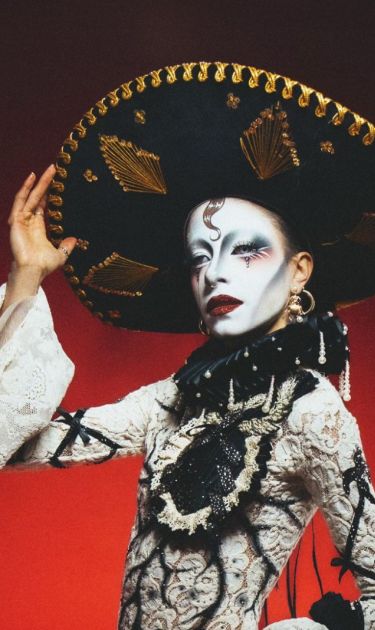When Sofia Camacho runs, it’s not just about speed—though they can run 26.2 miles in less than two and a half hours. And when they perform in drag, it’s not solely to look hot, cute, or glam—despite the fact that they can turn a look. For the New York-based Mexican athlete and drag artist, being part of the city’s queer nightlife scene and its highly competitive running circuits is primarily about one thing: freedom.
As a trans, nonbinary performer who races in women’s categories and moonlights as Xana Whoria—a blood-splattered, prosthetic-wearing drag creature—Camacho is breaking binaries at every turn. “I’m running faster now than I did in college,” they say, crediting not just extensive training but recently achieved gender euphoria. “Living as myself makes everything lighter, even my legs.”
Remezcla sat down with Camacho to talk about finding their identity through movement, gender dysphoria, the ever-evolving art of drag, and how community has helped them find their true identity.
Finding Identity Through Movement
Camacho ran competitively in high school and college, serving as captain of women’s teams throughout. But even during those achievements, something never felt right. “I just didn’t vibe with the girls ever,” they say. “Everything always felt like a costume. Girl clothes, boy clothes—everything.”

It wasn’t until they tried on a binder for the first time that the pieces began to click. “I think I got emotional when I first put it on. I was like, this makes so much sense.”
Still, Camacho’s gender journey has been shaped by the logistics of sport. Because they currently race in women’s divisions, they’ve delayed starting testosterone. “I want to achieve a lot of my running goals, if not all of them, now, so that when I do start testosterone, I don’t go through puberty when I’m 30,” says the 26-year-old.
In the meantime, they’re exploring options like top surgery and finding a rhythm with training that aligns with who they are—not who the system says they have to be.

“Running on a women’s team felt like running with a weighted vest,” they say. “Something didn’t feel right, and I couldn’t take it off. Every step just felt heavier.”
Drag as Self-Invention
A self-described “drag monster,” Camacho’s drag persona, Xana Whoria, is anything but conventional. They are inspired by clowns, the prominence of the letter X in Mexican Spanish and Indigenous languages, and a childhood obsession with carrots. (Fun fact: The athlete and artist once ate so many carrots that their skin turned orange.) Xana is not what people would call polished pageant drag—and that’s the whole point.
“My drag is so serious a lot of the time, and my name is just Xana Whoria. A f*cking carrot,” they laugh. “But there’s a ring to it. It sounds draggy.”
For Camacho, drag wasn’t about fitting into a pre-existing category—it was about creating their own. “Sometimes I’m a clown. Sometimes I put on a human hair unit. Sometimes I’m just Xana. Once I realized I could do whatever I wanted, it was just great.”
They credit the New York nightlife scene for not only accepting but celebrating that uniqueness. “I was going out in clown paint during finals. I didn’t even know it was drag at first. Then people were like, ‘Why aren’t you on stage yet?’”
It didn’t take long for Camacho to find their way on that stage. Now, they perform regularly and experiment freely—sometimes with blood illusions, sometimes with fire, sometimes with anatomical art. “I went through a phase of trying to conform, but people actually kind of like what I do. So I started caring less.”
Community and Clarity
That same freedom has spilled into Camacho’s running life. After years of overtraining and perfectionism, they’ve found a new level of ease—and success. “I had no business winning [the Nike After Dark Tour half marathon] in LA. I was injured, I was only running 30 minutes every other day, I was not trained,” they admit. But still, they won. (This writer ran that same race and was only on mile five when Camacho bolted to the finish line, which was only about a mile or two away. Their total time? One hour, 15 minutes, and 25 seconds.)
Living authentically has cleared mental space for joy, creativity, and performance as well. “Now that I do have community, I don’t feel alienated anymore, and everything feels normal,” they say. “I can do [art and running] better because I’m living how I want to.”
They credit their girlfriend, who is also trans, for helping reframe their mindset. “She always says, your superpower is your brain. No one has what you have with your brain.”




